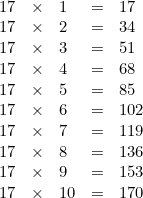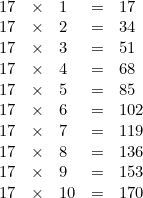Table of 17
Introduction
The maths table is a fundamental concept in mathematics that teaches students how to find the multiples of a number. We have been taught multiplication tables since primary school. These maths tables assist us in solving multiplication problems quickly. It is consequently vital for pupils to memorise maths tables in order to solve complex calculations rapidly. Let's review the 17 maths tables and some tips for remembering them.
What are Maths Tables?
Elementary arithmetic equations are essential in our daily lives. Using calculators for simple calculations may impair your understanding of scales and enormities. Aside from your preparation, speed and accuracy are critical in competitive tests. Even if calculators are permitted, students with superior mathematical skills will always have an advantage over students who rely on calculators for basic calculations.
Mathematical tables are necessary for grasping mathematics. Students are advised to have a firm grasp of maths tables; otherwise, understanding the other areas of mathematics would be difficult. Students will likely struggle with basic maths concepts such as decimals, percentages, fractions, ratios, and so on if they do not have elementary knowledge of maths tables. Once you've learned these multiplication tables, you'll remember them for the rest of your life.
Solved Examples
How many times should 17 be multiplied to get 238 using the table of 17?
Ans:
According to the 17 times table
\begin{equation}17 \times 14=238\end{equation}
![]()
Hence, 14 times 17 is 238.
Raghav has collected some images from 17 different books. From each book, he gets 7 images. Find the number of images he has using the table of 17.
Ans:
Total number of images raghav has from each book = 7
Total number of books = 17
By using table of 17
We can calculate the number of images
\begin{equation}17 \times 7=119\end{equation}
![]()
Rajni bought 15 oranges for Rs. 255. What is the cost of two oranges?
Ans:
The cost of 15 oranges is Rs. 255.
So, the cost of 1 orange
\begin{equation}255 / 15=17\end{equation}
![]()
Therefore, the cost of two oranges
\begin{equation}17 \times 2=34\end{equation}
![]()
How many days will it take two people to finish the same task if 17 people finish it in 4 days?
Ans:
Given that a task is finished by 17 persons in 4 days.
Therefore, one person can finish the same task in
\begin{equation}17 \times 4\end{equation}
![]()
Therefore, it will take two individuals = 34 days (68 divided by two) to finish the identical task.
What is 170 plus 10 times the number 17?
Ans:
\begin{equation}17 \times 10+170=340\end{equation}
![]()
Multiplication Table of 17
A 17-times multiplication table can help kids become more adept at maths. The 17 times table is helpful for long division and multiplication problems. Students find it much simpler to mentally evaluate challenging maths problems when they can recall the table of 17.
\begin{array}{lllll}17 & \times & 1 & = & 17 \\17 & \times & 2 & = & 34 \\17 & \times & 3 & = & 51 \\17 & \times & 4 & = & 68 \\17 & \times & 5 & = & 85 \\17 & \times & 6 & = & 102 \\17 &\times & 7 & =& 119 \\17 & \times & 8 & = & 136 \\17 & \times & 9 & = & 153 \\17 & \times & 10 & = & 170\end{array}

Frequently Asked Questions (FAQs)
Memorise maths tables by reading them repeatedly. Students can write each table on paper and read it aloud several times. They can also try to remember the multiples of every number, such as 3, 6, 9, 12, 15, 18, 21, 24, 27, 30, and so on.
Seventeen has no factors.
Only seventeen is a prime number that sums four consecutive primes (2, 3, 5, 7). Any other four consecutive primes would always result in an even number when added together, making them divisible by 2, not prime.
Multiplication is a process of repeatedly adding things. A natural integer is added seventeen times according to a straightforward rule in the multiplication table for 17, and the outcome is a multiple of seventeen.
For example, multiplying six by 17 reveals that 17+17+17+17+17+17 Equals 102.
The basic purpose of multiplication is to make addition simpler.
\begin{array}{lllll}17 & \times & 1 & = & 17 \\17 & \times & 2 & = & 34 \\17 & \times & 3 & = & 51 \\17 & \times & 4 & = & 68 \\17 & \times & 5 & = & 85 \\17 & \times & 6 & = & 102 \\17 &\times & 7 & =& 119 \\17 & \times & 8 & = & 136 \\17 & \times & 9 & = & 153 \\17 & \times & 10 & = & 170\end{array}

Applications for Admissions are open.
As per latest syllabus. Physics formulas, equations, & laws of class 11 & 12th chapters
JEE Main Important Chemistry formulas
Get nowAs per latest syllabus. Chemistry formulas, equations, & laws of class 11 & 12th chapters
JEE Main high scoring chapters and topics
Get nowAs per latest 2024 syllabus. Study 40% syllabus and score upto 100% marks in JEE
JEE Main Important Mathematics Formulas
Get nowAs per latest syllabus. Maths formulas, equations, & theorems of class 11 & 12th chapters